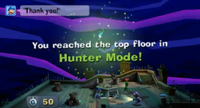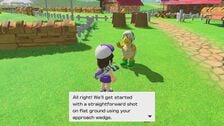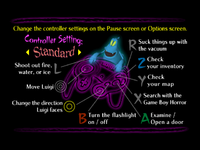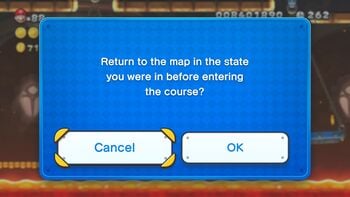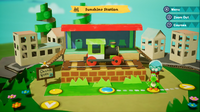List of fonts: Difference between revisions
Tag: Mobile edit |
Tag: Mobile edit |
||
| Line 3: | Line 3: | ||
==First ''Mario'' font== | ==First ''Mario'' font== | ||
The first ''Mario'' font is an uneven sans serif typeface designed by [[Nintendo]] in 1988. It is used for the logos of, and later interfaces in ''[[Mario (franchise)|Mario]]'' games from ''[[Super Mario Bros. 3]]'' to ''[[Mario Sports Mix]]'', though it was modified in 1996 for [[Super Mario 64]], with that version becoming more prominent. | The first ''Mario'' font is an uneven sans serif typeface designed by [[Nintendo]] in 1988. It is used for the logos of, and later interfaces in ''[[Mario (franchise)|Mario]]'' games from ''[[Super Mario Bros. 3]]'' to ''[[Mario Sports Mix]]'', though it was modified in 1996 for ''[[Super Mario 64]]'', with that version becoming more prominent. | ||
It was replaced with the second ''Mario'' font that appeared in ''[[Super Mario 3D Land]]'', though the first ''Mario'' font was still used through ''[[Paper Mario: Sticker Star]]'', albeit the game logo uses the second ''Mario'' font. | It was replaced with the second ''Mario'' font that appeared in ''[[Super Mario 3D Land]]'', though the first ''Mario'' font was still used through ''[[Paper Mario: Sticker Star]]'', albeit the game logo uses the second ''Mario'' font. | ||
Revision as of 18:08, November 21, 2022
It has been requested that more images be uploaded for this article. Remove this notice only after the additional image(s) have been added.
This is a list of fonts used in games and related media within the Mario franchise.
First Mario font
The first Mario font is an uneven sans serif typeface designed by Nintendo in 1988. It is used for the logos of, and later interfaces in Mario games from Super Mario Bros. 3 to Mario Sports Mix, though it was modified in 1996 for Super Mario 64, with that version becoming more prominent.
It was replaced with the second Mario font that appeared in Super Mario 3D Land, though the first Mario font was still used through Paper Mario: Sticker Star, albeit the game logo uses the second Mario font.
Second Mario font
The second Mario font is an uneven sans serif typeface designed by Nintendo in 2011. It is used for the interface in Mario games since Super Mario 3D Land.
Gallery
Super Mario Maker font
The Super Mario Maker font is a geometric sans serif typeface designed by Nintendo in 2015 and 2019, with the lowercase typeface designed on the latter date. It is used for the interface in Super Mario Maker and Super Mario Maker 2, with the lowercase typeface used in the latter game.
AdLib BT/Alor
AdLib BT/Alor is an uneven sans serif typeface from Alan Carr. It is used for the interface in the following games:
Anito
Anito (アニト) is a rounded sans serif typeface from Type Labo. It is used for the interface in Super Mario Maker.
Arial
Arial is a sans serif typeface from Monotype. It was used for the HUD of the E3 preview of New Super Mario Bros. Wii.
Chiaro
Chiaro (キアロ) is a sans serif typeface from Fontworks. It is used for controller setting texts in Luigi's Mansion.
DF UD Gothic
DF UD Gothic (DF UDゴシック体) is a Universal Design sans serif typeface from Dynacomware. It is used for the interface in Super Mario Maker 2 for the Japanese language.
GigaG
GigaG (ギガG) is a sans serif typeface from Visual Design Laboratory (視覚デザイン研究所). It is used for the interface in Mario Golf: Super Rush for the Japanese language.
Handel Gothic
Handel Gothic is a sans serif typeface originally from FotoStar. Handel Gothic with a straight leg on "R", a straight lower leg on "k", and a double-v "w", modified with a short line on the top left of the "1", is used for the interface in Luigi's Mansion 3 for Western languages.
Humming
Humming (ハミング) is a rounded sans serif typeface from Fontworks. It is used for the interface in Mario & Luigi: Dream Team.
Kurokane
Kurokane (くろかね) is a sans serif typeface from Fontworks. It is used for the sticker text in Mario Party Superstars for the Japanese language.
Kyo Geki
Kyo Geki (京劇体) is an uneven sans serif typeface from DynaComware. It is used for the interface in Luigi's Mansion: Dark Moon for kana and kanji and in the Japanese and American versions of Mario Party 8.
Logona
Logona (ロゴナ) is a sans serif typeface from Visual Design Laboratory. Its Latin characters are similar to Eurostile. It is used for the interface in Mario Golf: Super Rush for the Japanese language.
Mario Party Textbox
Mario Party Textbox is used for the interface in the English version of Mario Party.
Mario Party Textbox FR/DE
Mario Party Textbox FR/DE is used for the interface in the French and German versions of Mario Party.
Mario Party 2/3 Textbox
Mario Party 2/3 Textbox is, as the name implies, used for the interface in Western versions of Mario Party 2 and 3.
Mario Party 4-7 Textbox
Mario Party 4-7 Textbox is, as the name implies, used for the interface in Western versions of Mario Party 4, 5, 6, and 7, as well as Dance Dance Revolution: Mario Mix and the European version of Mario Party 8.
Mario Party Hudson
Mario Party Hudson is used for large text in all Hudson Soft-developed Mario Party installments.
Mystery
Mystery (ミステリ) is an uneven serif typeface from Fontworks. It is based on Matisse (マティス), a serif typeface also from Fontworks. It is used for the location name HUD in Luigi's Mansion.
Neo Sans
Neo Sans is a sans serif typeface from Monotype. It is used for the interface in Mario & Sonic at the Olympic Games Tokyo 2020 for Western languages.
New Rodin
New Rodin (ニューロダン) is a sans serif typeface from Fontworks. Its Latin characters are similar to Eurostile. It is used for the interface in the following games:
- Mario & Luigi: Dream Team
- Mario Kart 8
- Mario & Luigi: Paper Jam
- Mario Kart 8 Deluxe
- Mario & Luigi: Superstar Saga + Bowser's Minions
- Mario Tennis Aces
- Super Mario Party
- Mario & Luigi: Bowser's Inside Story + Bowser Jr.'s Journey
- Mario Kart Tour
- Mario Golf: Super Rush (Western languages)
- Mario Party Superstars
Pop Fury
Pop Fury (Popフューリ) is a Point of Purchase typeface from Fontworks. It is used for the controller setting label and the letters labeling the controller buttons in Luigi's Mansion.
Pop Happiness
Pop Happiness (Popハッピネス) is a Point of Purchase typeface from Fontworks. It is used for the interface in the following games:
- Luigi's Mansion
- Super Mario Sunshine (Western languages)
- Mario Power Tennis
- Super Mario Galaxy (Western languages)
- Super Mario Galaxy 2 (Western languages)
- WarioWare Gold
Additionally, in Mario Tennis for the Nintendo 64, it is used on the court selection screen when listing ball speed/bounce.
Pop Joy
Pop Joy (Popジョイ) is a rounded Point of Purchase typeface from Fontworks. It is used for the interface in the Paper Mario games for Western languages since Paper Mario: The Thousand-Year Door, as well as Mario Golf: Toadstool Tour. Pop Joy is also used in WarioWare Gold as the text for Penny's stage.
Pop Joy in Paper Mario: Sticker Star
Pop Joy in Paper Mario: Color Splash
Pop Joy in WarioWare Gold
Pop Joy in Paper Mario: The Origami King
POP Mix
POP Mix (POPミックス) is a Point of Purchase typeface from DynaComware. It is used for the interface in Luigi's Mansion 3 for the Japanese language.
RocknRoll
RocknRoll (ロックンロール) is a Point of Purchase typeface from Fontworks. It is based on Rodin. It is used for the interface in Mario Party 10 for Western languages.
Rodin Maria
Rodin Maria (ロダンマリア) is a sans serif typeface from Fontworks. It is Rodin with Maria kana. It is used for the interface in the following games:
- Super Mario Sunshine (Japanese language)
- Super Mario Galaxy (Japanese language)
- Super Mario Galaxy 2 (Japanese language)
- Mario Party 10 (Japanese language)
Rodin NTLG
Rodin NTLG (ロダンNTLG) is a sans serif typeface from Fontworks. It is Rodin with New Type Labo Gothic kana. The kana stroke ends are horizontal or vertical. Rodin NTLG is the system font on Nintendo GameCube, Wii, Nintendo DSi, Nintendo 3DS and Wii U. It is used for the interface in the following games:
- Mario & Sonic games from Mario & Sonic at the Olympic Games to the Nintendo 3DS version of Mario & Sonic at the Rio 2016 Olympic Games for Western languages and the Wii U version of Mario & Sonic at the Rio 2016 Olympic Games for the Japanese language
- Mario Kart Wii
- Mario Kart 7
- Super Mario Maker
- Super Mario Odyssey
- Super Mario 3D World + Bowser's Fury
Rodin Wanpaku
Rodin Wanpaku (ロダンわんぱく) is a sans serif typeface from Fontworks. It is Rodin with New Wanpaku Gothic kana. It is used for the interface in the following games:
Rowdy
Rowdy (ロウディ) is a sans serif typeface from Fontworks. It is based on Rodin. It is used for the interface in the following games:
Seurat
Seurat (スーラ) is a rounded sans serif typeface from Fontworks. It is used for the interface in the following games:
- New Super Mario Bros. Wii
- Super Mario 3D Land
- New Super Mario Bros. 2
- New Super Mario Bros. U
- Paper Mario games since Paper Mario: Sticker Star (Japanese language)
- New Super Luigi U
- Super Mario 3D World
- Mario & Luigi: Paper Jam
- Mario Party: Star Rush
- Mario & Luigi: Superstar Saga + Bowser's Minions
- Mario Party: The Top 100
- Mario & Luigi: Bowser's Inside Story + Bowser Jr.'s Journey
- New Super Mario Bros. U Deluxe
Seurat Capie
Seurat Capie (スーラキャピー) is a rounded sans serif typeface from Fontworks. It is Seurat with Capie kana. It is used for the interface in the following games:
- Paper Mario: The Thousand-Year Door (Japanese language)
- Super Paper Mario (Japanese language)
Slump
Slump (スランプ) is a rounded sans serif typeface from Fontworks. It is based on Seurat. It is used for subtitles in Super Mario Sunshine.
So Gei
So Gei (綜藝体) is a sans serif typeface from DynaComware. It is used for the interface in the following games:
- Super Mario Maker (Japanese language)
- Super Mario Maker 2 (Japanese language)
- Luigi's Mansion 3 (Japanese language)
- Mario Party 8
TheSans
TheSans is a sans serif typeface from LucasFonts, designed by Lucas de Groot. A version of this typeface, TheSans Rio 2016, is used for the interface in the Wii U version of Mario & Sonic at the Rio 2016 Olympic Games for Western languages.
UD Kakugo
UD Kakugo (UD角ゴ) is a Universal Design sans serif typeface from Fontworks. Its Latin characters are classified as humanist. It is used for the interface in Super Mario Maker 2 for Western languages. It is also used for the sticker text in Mario Party Superstars for Western languages.
UD Marugo
UD Marugo (UD丸ゴ) is a Universal Design rounded sans serif typeface from Fontworks. It is used for the interface in Super Mario Party for Western languages.
UD Shin Go
UD Shin Go (UD新ゴ) is a Universal Design sans serif typeface from Morisawa. Its Latin characters and numerals come from ClearTone SG, a humanist sans serif typeface also from Morisawa, with slight modifications, particularly in the letter "J". In UD Shin Go, "J" sits on the baseline; while in ClearTone SG, "J" descends below the baseline. UD Shin Go modified with a single story "g" from Latin small letter script g is the system font on Nintendo Switch. The unmodified UD Shin Go with a double story "g" is used for the interface in Mario & Sonic at the Olympic Games Tokyo 2020.
Yuruka
Yuruka (ユールカ) is a Point of Purchase typeface from Fontworks. It is used for the interface in Yoshi's Crafted World.

